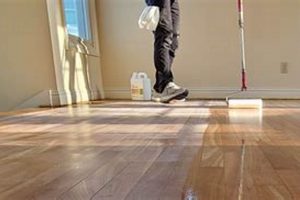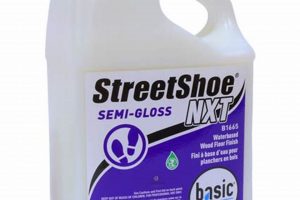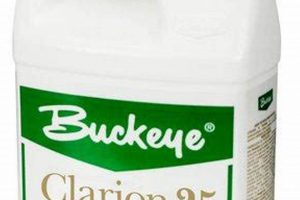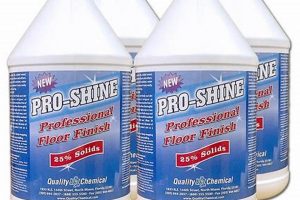A transparent coating applied to timber flooring enhances its inherent beauty without altering its natural color. This protective layer shields the wood from daily wear, such as scratches, scuffs, and spills, while allowing the grain and texture to remain visible. An example is a water-based polyurethane used on oak flooring to preserve the light tone of the wood.
The application of such a treatment is essential for prolonging the lifespan of wooden floors. By creating a barrier against moisture and impact, it minimizes the need for frequent repairs and refinishing. Historically, oils and waxes were employed for this purpose, but modern formulations offer superior durability and resistance to environmental factors. This results in a more sustainable and cost-effective flooring solution over time.
Understanding the different types of these coatings, their application processes, and maintenance requirements is crucial for achieving optimal results. The subsequent sections will delve into the various categories available, provide guidance on selecting the appropriate product for specific needs, and outline best practices for ensuring a lasting and attractive result.
Application Guidance for Transparent Timber Flooring Coatings
The following guidelines are designed to maximize the performance and longevity of treatments designed to protect and enhance timber floors without obscuring their natural appearance.
Tip 1: Surface Preparation is Paramount. Thoroughly sand and clean the flooring before application. Remove all traces of previous coatings, dirt, and debris. An uneven surface compromises adhesion and the final aesthetic.
Tip 2: Adhere to Manufacturer’s Instructions. Strictly follow the manufacturer’s recommendations regarding application methods, drying times, and the number of coats. Deviations can lead to premature failure or an undesirable appearance.
Tip 3: Control Environmental Conditions. Apply the product in a well-ventilated area with moderate temperature and humidity. Extreme conditions can negatively impact drying and curing.
Tip 4: Utilize Appropriate Application Tools. Employ high-quality brushes, rollers, or applicators specifically designed for the selected product. Using the wrong tools can result in streaks, bubbles, or uneven coverage.
Tip 5: Apply Thin, Even Coats. Multiple thin coats are preferable to a single thick coat. Thin coats dry more evenly and reduce the risk of cracking or peeling.
Tip 6: Allow Adequate Drying Time Between Coats. Ensure each coat is fully dry before applying the next. Insufficient drying time can trap solvents and lead to a cloudy or soft finish.
Tip 7: Consider a Test Area. Before applying to the entire floor, test the product in an inconspicuous area to verify compatibility and ensure the desired appearance.
Tip 8: Maintain Consistent Application Technique. Maintain a consistent speed and pressure throughout the application process. This helps ensure a uniform and professional-looking result.
Adhering to these best practices results in enhanced protection, longevity, and aesthetic appeal of wooden floors.
The subsequent section provides detailed insights into maintenance strategies to ensure continued preservation of these floor coverings.
1. Protection from abrasion
Abrasion, the wearing away of a surface due to friction, poses a significant threat to the longevity and appearance of timber flooring. A durable surface treatment is crucial to mitigate the effects of daily wear and tear. Coatings formulated to resist abrasion are integral in maintaining the integrity and aesthetic quality of wooden floors.
- Hardness and Durability of the Coating
The inherent hardness of the substance is a primary determinant of its ability to withstand abrasion. Formulations containing components like aluminum oxide or ceramic particles exhibit superior resistance to scratching and scuffing compared to softer options. The use of these materials directly correlates with the ability of the coating to maintain its protective properties over time.
- Flexibility and Impact Resistance
While hardness is essential, a degree of flexibility is also necessary. Brittle, rigid treatments are prone to cracking or chipping under impact. Ideally, the treatment should possess a balance of hardness and flexibility, allowing it to absorb minor impacts and deformations without compromising its protective barrier. Polyurethane coatings often demonstrate this balance.
- Number and Thickness of Applied Coats
The number and thickness of the applied layers directly influence the level of protection offered. Multiple thin layers generally provide better resistance to abrasion than a single thick layer, as they distribute the wear and tear more evenly. Proper application technique ensures uniform thickness and consistent protection across the entire floor surface.
- Maintenance and Recoating
Even the most durable surface will eventually show signs of wear. Regular maintenance, including sweeping and cleaning, helps to minimize the accumulation of abrasive particles. Periodic recoating replenishes the protective barrier and restores the floor’s appearance. Establishing a routine maintenance schedule extends the life of the flooring and preserves its original aesthetic.
The effectiveness of any surface treatment is ultimately judged by its ability to resist abrasion and maintain its integrity over time. Selecting a product with appropriate hardness, flexibility, and ease of maintenance ensures the long-term preservation of timber floors, minimizing the need for costly repairs or replacements.
2. Maintaining wood's visibility
The fundamental objective of applying a treatment designed to enhance timber flooring often rests upon preserving its inherent visual characteristics. This objective directly dictates the selection of transparent formulations. The inherent grain patterns, color variations, and natural textures of the wood are valued aesthetic components that should not be obscured. A coating that diminishes or alters these features undermines the purpose of using wood as a flooring material. Clear coatings are explicitly engineered to protect the wood while showcasing its natural beauty. An example illustrating this point is the use of a clear water-based polyurethane on maple flooring. The coating provides a protective layer against scratches and moisture without altering the light color and subtle grain patterns of the maple.
The significance of this connection extends to the perceived value of the flooring. When wood’s natural appearance is maintained, it reinforces the authenticity and perceived quality of the installation. This is particularly crucial in high-end residential or commercial settings where the aesthetic impact of the flooring contributes significantly to the overall ambiance. The application of clear treatments is not merely about protection; it is about enhancing and celebrating the material’s intrinsic qualities. Another example would be applying a clear sealant to reclaimed hardwood flooring, allowing the unique character marks and age-related variations in the wood to remain visible, adding to its rustic appeal.
In summary, the desire to maintain the wood’s visibility is the driving force behind the use of transparent treatments. This choice provides protection without compromising the visual appeal that makes wood flooring desirable. Understanding this connection is essential for selecting the appropriate product and ensuring the flooring achieves both protective and aesthetic goals. Challenges may arise in selecting a treatment that provides adequate protection without yellowing or clouding over time, requiring careful consideration of the product’s chemical composition and UV resistance. This connection underscores the importance of clear treatment options for enhancing both beauty and sustainability.
3. Enhancing natural aesthetics
The application of a transparent protective layer on timber flooring is intrinsically linked to the goal of accentuating its inherent aesthetic qualities. The treatment’s primary purpose is to protect the wood while simultaneously enhancing its visual appeal, thereby maximizing the flooring’s contribution to the overall ambiance of a space.
- Highlighting Grain and Texture
Clear coatings facilitate the preservation and enhancement of the wood’s natural grain patterns and textures. The transparency of the treatment allows these features to remain visible, creating a visually appealing surface. An example includes the application of a clear matte finish to oak flooring, enhancing the grain without adding excessive shine. This preservation is critical for maintaining the aesthetic value of the wood.
- Color Preservation
A key aspect of enhancing aesthetics is maintaining the wood’s original color. Certain coatings can alter or yellow the wood over time. High-quality clear treatments are formulated to resist yellowing, ensuring that the natural tone of the wood remains consistent. This preservation is vital, particularly in designs where specific wood tones are intentionally selected for their aesthetic contribution.
- Surface Sheen and Reflectivity
The level of sheen influences the overall visual impact of the floor. Clear coatings are available in a range of sheens, from matte to high gloss, allowing for customization to suit specific aesthetic preferences. A matte finish offers a subtle, natural look, while a high-gloss finish provides a more dramatic, reflective surface. The choice of sheen affects how the floor interacts with light and contributes to the ambiance of the room.
- Minimizing Visual Imperfections
While preserving the wood’s natural character is important, a clear treatment can also minimize minor visual imperfections. The smooth surface created by the coating can reduce the appearance of scratches, dents, and other blemishes, enhancing the overall visual appeal of the floor. This minimization of imperfections contributes to a cleaner, more polished look.
Ultimately, the choice of clear wood floor finish is driven by the desire to protect and enhance the aesthetic qualities of the timber. By preserving natural grains, textures, and colors, a transparent protective treatment allows the wood to function as both a durable flooring material and a key element of design, adding value and beauty to the interior space. The integration of these elements provides both protection and beauty.
4. Extending Floor Lifespan
The utilization of a transparent timber flooring coating is intrinsically linked to the objective of prolonging the lifespan of the underlying wooden material. The application of such a coating serves as a preventative measure against various forms of damage, thereby minimizing the need for premature replacement or extensive restoration. The protective barrier created by the coating shields the wood from abrasion, moisture, and chemical exposure, all of which contribute to its deterioration over time. For example, in a high-traffic commercial setting, applying a durable, transparent polyurethane coating to a hardwood floor can significantly reduce wear and tear, preventing the need for frequent refinishing and extending the floor’s service life. Therefore, selecting and applying the correct coating represents a direct investment in the long-term preservation of the flooring.
The choice of coating material, its application method, and the regularity of maintenance directly influence the effectiveness of this lifespan extension. Polyurethane-based products, known for their abrasion resistance, are frequently employed in areas subject to heavy foot traffic. Water-based coatings, with lower VOC emissions, provide an environmentally conscious alternative, albeit potentially requiring more frequent reapplication compared to their oil-based counterparts. Furthermore, proper surface preparation prior to coating application is critical for adhesion and overall performance. Regular cleaning and the prompt repair of any damage, such as scratches or water stains, will further enhance the floor’s longevity. An example would be regularly cleaning a clear-coated residential oak floor with a pH-neutral cleaner to prevent damage from dirt and spills. This small act can dramatically extend the lifespan of the wood.
In summary, the application of a transparent timber flooring coating is a crucial strategy for extending the lifespan of wooden floors. This practice minimizes damage, reduces maintenance frequency, and preserves the aesthetic value of the wood over time. The selection of appropriate coating materials and the adherence to proper application and maintenance procedures are essential for maximizing the benefits and ensuring the long-term sustainability of the flooring investment. Neglecting this protective step can lead to accelerated wear, costly repairs, and premature floor replacement, ultimately negating the initial investment in the timber flooring.
5. Chemical resistance
The capacity of a transparent timber flooring coating to withstand exposure to various chemical substances is a critical determinant of its long-term performance and aesthetic integrity. Chemical resistance directly influences the coating’s ability to protect the wood from staining, discoloration, and structural damage caused by common household spills, cleaning agents, and other chemical exposures. A deficiency in this property can lead to irreversible harm, necessitating costly repairs or complete floor replacement. For instance, the accidental spillage of acidic substances such as vinegar or citrus juice onto a poorly protected wood floor can result in etching and discoloration, permanently marring the surface. The inclusion of chemical-resistant additives in the formulation of transparent wood floor finishes is therefore essential to maintaining the floor’s appearance and structural soundness.
Further consideration must be given to the types of chemicals likely to be encountered in the floor’s environment. Residential settings require resistance to common household cleaners, detergents, and food-related substances. Commercial or industrial environments may necessitate protection against more aggressive chemicals, such as solvents, oils, or acids. The selection of a specific transparent wood floor finish should therefore be guided by a thorough assessment of the potential chemical exposures in its intended application. For example, a polyurethane finish, known for its robust chemical resistance, may be suitable for a kitchen or dining area, while a specialized epoxy coating might be preferred in a laboratory or workshop where exposure to harsh chemicals is more likely. Regular maintenance and prompt cleanup of spills also contribute significantly to mitigating the impact of chemical exposure, regardless of the coating’s inherent resistance.
In summary, chemical resistance is a paramount performance characteristic of transparent timber flooring coatings. Its presence safeguards the wood from damage caused by chemical substances, ensuring the floor’s longevity and aesthetic appeal. The appropriate selection of coating materials, informed by an understanding of potential chemical exposures, combined with diligent maintenance practices, constitutes a comprehensive approach to protecting and preserving wooden floors. The lack of sufficient chemical resistance will result in irreversible damage, potentially shortening the lifespan of the flooring and diminishing its aesthetic value, therefore it is an important element for any clear wood floor finish.
Frequently Asked Questions
This section addresses common inquiries regarding the properties, application, and maintenance of transparent coatings designed for timber floors.
Question 1: What are the primary advantages of utilizing a coating on wooden flooring?
The primary advantages include protecting the wood from abrasion, moisture, and chemical exposure; enhancing its natural aesthetic qualities; and extending its overall lifespan.
Question 2: How does the selection of material impact the durability of timber flooring?
Material selection directly influences the floor’s resistance to scratching, scuffing, and impact. Harder substances, such as polyurethane or acrylic, offer superior protection compared to softer materials like wax.
Question 3: What factors should be considered when choosing material suitable for residential application?
Considerations include the level of foot traffic, potential for spills, aesthetic preferences, and the presence of any chemical sensitivities among occupants. Durability, ease of maintenance, and VOC emissions should all be evaluated.
Question 4: What maintenance practices are recommended for surfaces with these protective layers?
Recommended practices include regular sweeping or vacuuming to remove abrasive particles, prompt cleanup of spills, and periodic reapplication of the coating as needed to maintain the protective barrier.
Question 5: How can potential yellowing of timber flooring be mitigated?
Utilize coatings specifically formulated with UV inhibitors to minimize yellowing caused by sunlight exposure. Also, avoid the use of oil-based products, which are more prone to yellowing over time.
Question 6: What are the risks associated with improper application?
Improper application can result in uneven coverage, bubbling, peeling, or inadequate adhesion, compromising the floor’s protection and aesthetic appearance.
In conclusion, the informed selection and proper application, coupled with diligent maintenance, are essential for maximizing the benefits and longevity of timber flooring.
The subsequent section will elaborate on advanced techniques for achieving a professional result.
Conclusion
This exploration of clear wood floor finish has emphasized its vital role in protecting and enhancing timber flooring. The discussion highlighted the importance of abrasion resistance, maintaining wood’s natural visibility, aesthetic enhancement, lifespan extension, and chemical resistance. Selecting the appropriate type and adhering to proper application and maintenance protocols are critical for achieving optimal results. Failure to prioritize these factors can lead to compromised durability, diminished aesthetic appeal, and premature floor replacement.
The informed application of clear wood floor finish is not merely a superficial treatment but a strategic investment in the longevity and beauty of timber flooring. Continued research and development in coating technologies will undoubtedly yield further advancements in durability, sustainability, and aesthetic options. Professionals and homeowners alike are encouraged to stay abreast of these innovations to ensure the continued preservation and enhancement of timber flooring for generations to come.







